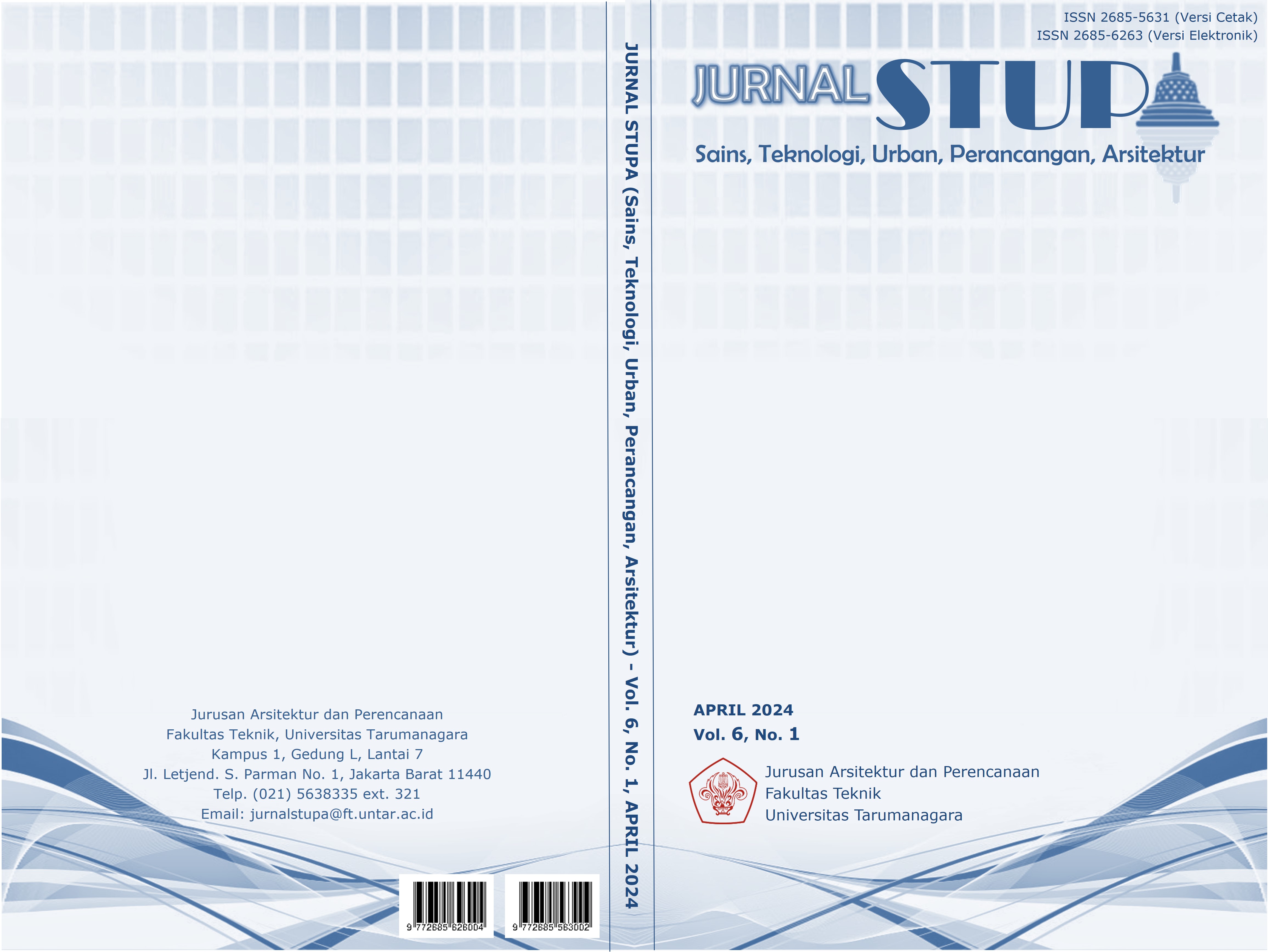EKSPLORASI PENGARUH DESAIN BANGUNAN TERHADAP KESEJAHTERAAN MENTAL DAN PENANGGULANGAN DEPRESI
Main Article Content
Abstract
This research delves into the significant role of architectural design in advancing mental well-being and its potential to address depression. In the midst of an era filled with pressure and stress, understanding the interconnection between the physical environment and mental health becomes increasingly vital. The research aims to identify architectural design principles that positively impact individual psychological aspects, encompassing elements such as natural lighting, spatial arrangement, access to nature, and art integration. The findings of this research indicate that architecturally responsive design to psychological needs has the potential to be a key factor in addressing the challenges of depression. By providing an environment that supports mental recovery, architectural design can play a crucial role in enhancing the overall well-being of society. The practical implications of this research provide impetus for architects, urban planners, and policymakers to create built spaces that are not only visually appealing but also contribute to individual psychological well-being. In summary, this research emphasizes that incorporating the dimension of mental well-being into built environment design has a significant positive impact in creating a holistically healthier society.
Keywords: Architecture; Depression; Mental disorders; Mental recovery
Abstrak
Penelitian ini menyelidiki peran yang signifikan dari desain arsitektur dalam memajukan kesejahteraan mental dan potensinya untuk mengatasi depresi. Di tengah-tengah era yang dipenuhi tekanan dan stres, pemahaman akan keterkaitan antara lingkungan fisik dan kesehatan mental menjadi semakin penting. Penelitian ini bertujuan untuk mengidentifikasi prinsip-prinsip desain arsitektur yang memiliki dampak positif pada aspek psikologis individu, mencakup elemen-elemen seperti pencahayaan alami, pengaturan ruang, akses ke alam, dan integrasi seni. Temuan dari penelitian ini menunjukkan bahwa desain arsitektur yang responsif terhadap kebutuhan psikologis memiliki potensi menjadi faktor kunci dalam menghadapi tantangan depresi. Dengan menyediakan lingkungan yang mendukung pemulihan mental, desain arsitektur dapat berperan penting dalam meningkatkan kesejahteraan masyarakat secara keseluruhan. Implikasi praktis dari penelitian ini memberikan dorongan kepada arsitek, perencana kota, dan pembuat kebijakan untuk menciptakan ruang binaan yang tidak hanya menarik secara visual, tetapi juga berkontribusi pada kesejahteraan psikologis individu. Secara singkat, penelitian ini menegaskan bahwa memasukkan dimensi kesejahteraan mental dalam perancangan lingkungan binaan memiliki dampak positif signifikan untuk menciptakan masyarakat yang lebih sehat secara holistik.
Article Details

This work is licensed under a Creative Commons Attribution-NonCommercial-ShareAlike 4.0 International License.
This work is licensed under a Jurnal Sains, Teknologi, Urban, Perancangan, Arsitektur/ STUPA Creative Commons Attribution-NonCommercial-ShareAlike 4.0 International LicenseReferences
Boubekri, M., Cheung, I. N., Reid, K. J., Wang, C. H., & Zee, P. C. (2014). Impact of windows and daylight exposure on overall health and sleep quality of office workers: a case-control pilot study. Journal of clinical sleep medicine, 10(6), 603-611.
Gifford, R., & Nilsson, A. (2014). Personal and social factors that influence pro‐environmental concern and behaviour: A review. International journal of psychology, 49(3), 141-157.
Kaplan, R., & Kaplan, S. (1989). The experience of nature: A psychological perspective. Cambridge university press.
Marcus, C. C., & Barnes, M. (Eds.). (1999). Healing gardens: Therapeutic benefits and design recommendations (Vol. 4). John Wiley & Sons.
Rojas, C. (2023, October 5). My House - The Mental Health House / Austin Maynard Architects. Retrieved from https://www.archdaily.com/873011/my-house-the-mental-health-house-austin-maynard-architects
Tapia, D. (2022, December 22). Vejle Psychiatric Hospital / Arkitema Architects. Retrieved from https://www.archdaily.com/901732/vejle-psychiatric-hospital-arkitema-architects
Ulrich, R. S., Simons, R. F., Losito, B. D., Fiorito, E., Miles, M. A., & Zelson, M. (1991). Stress recovery during exposure to natural and urban environments. Journal of environmental psychology, 11(3), 201-230.
Valenzuela, K. (2021, December 17). Nepean Mental Health Centre / Woods Bagot. Retrieved from https://www.archdaily.com/550968/nepean-mental-health-centre-woods-bagot
Velarde, M. D., Fry, G., & Tveit, M. (2007). Health effects of viewing landscapes—Landscape types in environmental psychology. Urban Forestry and Urban Greening, 6(4), 199-212.



